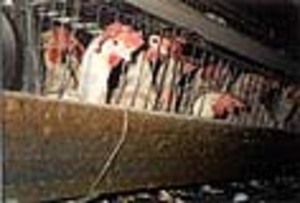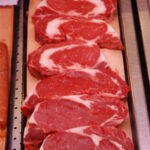It’s a frightening reality that more than two-thirds of our original American topsoil is now gone, with 85% of this loss attributed to livestock production. To create a meat-centered economy, 260 million acres of forest have been cleared for cropland. Seventy-eight calories of fossil fuel are required to produce only one calorie of beef protein; in contrast, only two calories are needed to produce one calorie of soybean protein. Almost half of the total amount of water used annually goes to grow feed and provide drinking water for cattle and other livestock.
According to the General Accounting Office, more plant species have been eliminated or threatened by livestock grazing than any other cause, and cattle grazing harms about 20% of endangered and threatened species. Some $37 million of taxpayer money is used to trap, poison, gas, and gun down almost one million wild animals and birds each year for livestock protection and pest control.
In the United States, every year 10 billion land animals and countless billions of fish raised at fish farms or taken from the wild are killed for food. The factory farming industry treats animals not as the sentient creatures they are, but rather as profitable commodities. They live in crowded cages and enclosures, are deprived of a normal social or family life, and spend their short lives largely without seeing daylight or being able to walk on the ground.
Forty million cows and calves are killed annually. Cows have a life span of 20-25 years, but a factory-farmed cow is used up by the time it is 3 to 4 years old and sent to the slaughterhouse. The organic waste from these giant farming operations is tremendous. Cattle alone are responsible for almost one billion tons of it, much of which finds its way into our groundwater.
On arrival at the slaughterhouse, animals that are too weak, sick, or injured to move are tied to the backs of trucks and dragged to areas where they are piled on top of each other (still alive) so that they can be easily killed and butchered. They are called downed animals, and they may suffer for days without food, water, or medical attention. These sick animals are often rejected for human consumption and wind up in pet food.
Of the 10 million biogenetically engineered dairy cows in the U.S., at least half spend their entire lives in crowded milking pens or barns with concrete floors. They are artificially inseminated on the rape rack-a charming term used by farmers-and their male calves are sold to veal producers within two days of birth, who chain them for 12 to 16 weeks inside dark, tiny crates. They are denied mother’s milk in order to produce the pale veal color. Factory-farmed dairy cows, like beef cows, are sprayed with pesticides and doused with antibiotics, hormones, and tranquilizers. The chemical residue is passed on to all those who consume their milk. Cow’s milk contains three times as much protein and 50% more fat than human milk, and is designed specifically to create a 300-pound cow within one year of birth, not to nourish humans.
Almost 10 billion chickens, turkeys and ducks are slaughtered each year for their meat. An additional four hundred million egg-laying hens live a hellish life, five to a cage only 18 inches in width (a chicken’s wingspan is 32 inches). Broiler chickens are raised in buildings with up to nine birds per square foot. Egg producers suffocate or grind up (alive) 280 million male chicks per year. Chicken processors, who kill about 5,000 chickens per hour, disregard hygiene because of lack of time and often just return bodies dropped on the floor to the processing line. A chicken factory uses up to 100 million gallons of water per day.
Approximately 100 million pigs are killed annually for food. Most pork, bacon, and ham comes from pigs who spend their short lives in stacked crates or barren cement pens with iron bars. Mother pigs are immobilized in pens almost constantly and treated as nothing more than breeding and feeding machines. The pig industry is a major contributor to pollution in this country, creating thousands of tons of waste that foul the air and infiltrate groundwater. Factory farming is a disastrous combination of environmental degradation, animal cruelty, and human health abuse. What can you do about it as a consumer? It’s not enough just to switch to eating the products of so-called humanely raised animals. They’re still slaughtered in the end, and their lives are often not much different from factory-farmed animals. The best way to protect yourself and your loved ones from the horrors of the animal farming industry is to switch to a plant-based diet.


